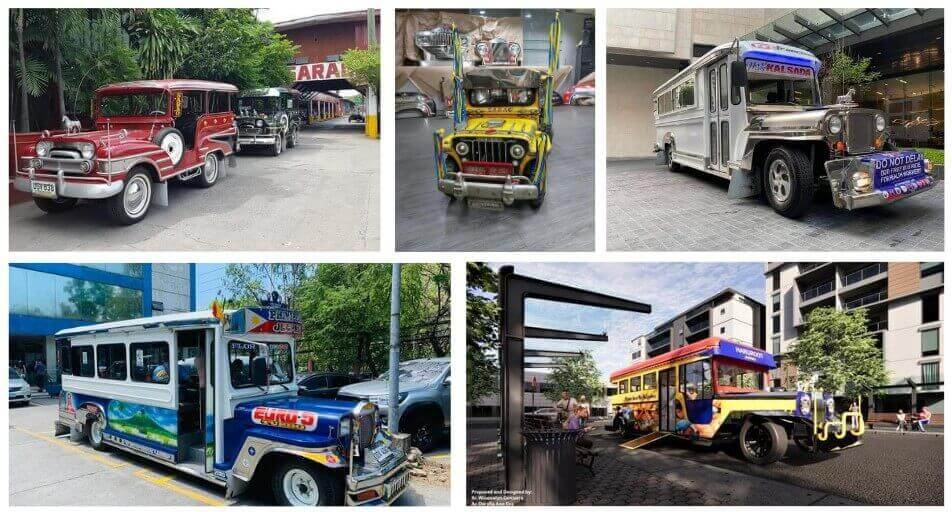
Here is a list of unique features of the traditional Philippine Jeepney, the public utility vehicle that hit the headlines this week after drivers staged a transport strike to reject the government’s modernization program which threatened to phase out the “King of the Road” as the world knows it.
The jeepney is unique to the Philippines and has historic, cultural, tourism, and pro-poor values that are championed by supporters of the retention of the popular jeepney.
Historic Witness of Filipino Innovation
The jeepney is a historic witness, taking its name from the American Willys military jeep discarded in the country at the end of World War II in 1945.
Filipino mechanics Leonardo Sarao and Lamberto Tabing pioneered the redesign of the military jeep to allow more riders, extending the vehicle’s chassis, adding seats, and placing a roof – building the first jeepney that would become the blueprint for succeeding manufacturers.
The two innovators went on to respectively establish Sarao Motors and Tabing Motors. Tabing stopped manufacturing in the 1990s. Sarao’s heirs continued the jeepney manufacturing business and have responded to the PUV Modernization Program by partnering with electric vehicle makers to make their jeepneys compliant with the new government standards.
Cultural Symbol
The Philippine Jeepney is an acknowledged cultural symbol for its Filipino character – its colorful paintwork and signboards, humorous texts on posters and stickers (the likes of “God Knows Hudas Not Pay”), fun accessories (stainless steel horses on the hood), and bench seats that encourage passengers to make room for each other and converse face-to-face during the ride.
The setup allows for a payment system that relies on the Bayanihan spirit, honor, and honesty as the fare is passed from passenger to passenger until it reaches the driver in front who in turn believes what the commuter states as the rider’s destination. Drivers also offered free rides to needy commuters, capturing the attention of netizens.
The vibrant face of the Philippines’ Jeepney has found its place in Hollywood films, US sports team uniforms, mini art, and Tamiya scale models for enthusiasts, among many other expressions of art.
The jeepney has been used as a planter art project, an urban forest tribute, and displayed Filipino resilience as it managed to stay on the road during Covid restrictions serving as a delivery vehicle.
Tourist Magnet
These representations of the Philippine Jeepney made it a tourist must-see that draws visitors to see up-close and get photographed beside it, riding or even living in one.
In fact, Filipino American celebrities visiting the country of their parents routinely introduce the road icon to co-stars, while foreign artists experience and praise the ride during their visit.
The Jeepney has also been repurposed as a camper jeepney for family travel and a campervan doubling as a rental house for tourists.
Pro-Poor Transport
The Jeepney transport system is currently mostly operated by individual single-unit jeepney owners and is patronized by students and workers who prefer the cheaper fare compared to buses.
The implementation of the public utility vehicle modernization program by the Land Transportation Franchising and Regulatory Board (LTFRB) requires jeepney operators to be consolidated into cooperatives or corporations, buy modernized mini-bus electric vehicles or fitted with an engine that complies with a Euro IV emission standard to reduce air pollution – by December 31 this year.
The government estimates a modernized “jeepney” costs up Php1.4 to 1.6 million but when acquired through loans, could cost up to Php2.8 million each – a staggering price for the daily wage earner drivers of the jeepney and one that would very possibly require a passenger fare hike to cover the purchase cost. Conversely, a traditional jeepney manufactured locally costs around Php150,000 to Php250,000.
Transport groups and affiliated industry workers protested the program by stopping the plying of regular jeepney routes starting March 6, 2023.
A Rappler feature article cites the Center for Energy, Ecology and Development (CEED) argument “that air pollution reduction efforts ‘would be negligible if modernization efforts focused on jeepneys compared to private vehicles'” considering that Jeepneys number only about 2% (250,000) of the total registered vehicles in the Philippines (9 million). The 50,000 diesel-powered units in Metro Manila contribute only 15% of total emissions.
CEED also observes that jeepney operators can hardly afford to purchase the modernized PUVs and that “private car owners would also be more likely financially capable of modernizing their vehicles”.
Keeping the Iconic Look
The #NoToJeepneyPhaseout mass action triggered the surfacing of various redesigns of the jeepney that carry the traditional look, from manufacturers like Francisco Motors, Sarao Motors, and independent designers of HaruRoot, among many others pic.twitter.com/coWZz8JSTt
— GoodNewsPilipinas.com (@GoodNewsPinas_) March 11, 2023
The “No To Jeepney Phaseout” mass action also triggered the surfacing of various redesigns of the jeepney that carry the traditional look, from manufacturers like Francisco Motors, Sarao Motors, and independent designers of HaruRoot, among many others.
On the day of the strike, the LTFRB also presented the Actona Corporation redesign of the modernized jeepney that carries the iconic look of the traditional ride – turning away from the initially proposed “jeepneys” that were actually mini-buses.
The new version carries the classic look of the traditional jeepney but is fitted with upgraded features such as a higher ceiling, doors on both sides, optional air-conditioning, CCTV cameras for security, and compliance with the Philippine National Standards set by the Department of Trade and Industry.
The government agency said the new model of the modern jeepney is locally manufactured and can accommodate more passengers.
Transitioning the old to the new is always a painstaking process. The transport industry and the government could make the transition from traditional to modernized jeepney a smoother process by taking into account the value of the traditional jeepney while infusing it with the new upgraded features at affordable costs – and staying on track with the public interest for convenient and safe rides at fair-priced fares.
Meantime, here’s a fun video highlighting the Philippine jeepney and its drivers:
Good News Pilipinas is a Lasallian Scholarum Awardee. TELL US your good news story tips by messaging GoodNewsPilipinas.com on Facebook, Twitter, Instagram, or e-mail editor@goodnewspilipinas.com and WATCH Good News Pilipinas TV YouTube & Good News Pilipinas TikTok for more Filipino Pride stories!










